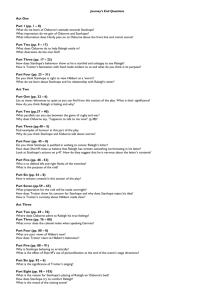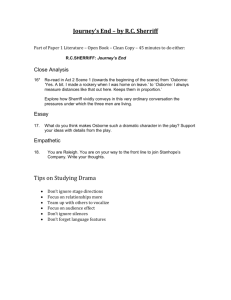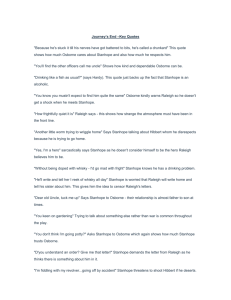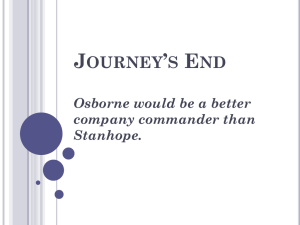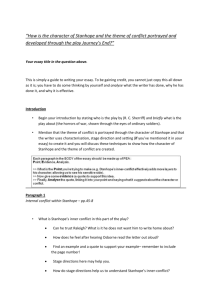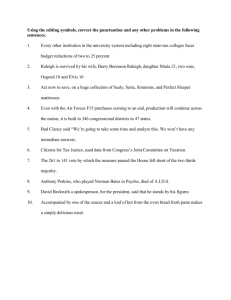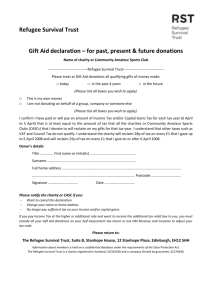Journey`s End Questions
advertisement
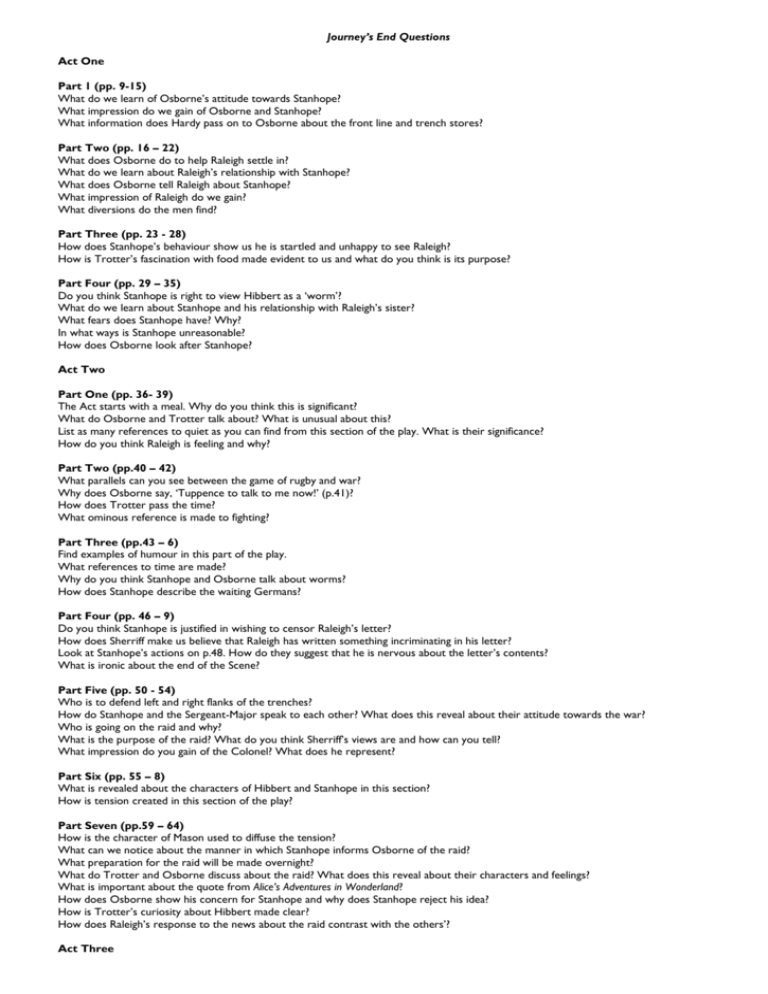
Journey’s End Questions Act One Part 1 (pp. 9-15) What do we learn of Osborne’s attitude towards Stanhope? What impression do we gain of Osborne and Stanhope? What information does Hardy pass on to Osborne about the front line and trench stores? Part Two (pp. 16 – 22) What does Osborne do to help Raleigh settle in? What do we learn about Raleigh’s relationship with Stanhope? What does Osborne tell Raleigh about Stanhope? What impression of Raleigh do we gain? What diversions do the men find? Part Three (pp. 23 - 28) How does Stanhope’s behaviour show us he is startled and unhappy to see Raleigh? How is Trotter’s fascination with food made evident to us and what do you think is its purpose? Part Four (pp. 29 – 35) Do you think Stanhope is right to view Hibbert as a ‘worm’? What do we learn about Stanhope and his relationship with Raleigh’s sister? What fears does Stanhope have? Why? In what ways is Stanhope unreasonable? How does Osborne look after Stanhope? Act Two Part One (pp. 36- 39) The Act starts with a meal. Why do you think this is significant? What do Osborne and Trotter talk about? What is unusual about this? List as many references to quiet as you can find from this section of the play. What is their significance? How do you think Raleigh is feeling and why? Part Two (pp.40 – 42) What parallels can you see between the game of rugby and war? Why does Osborne say, ‘Tuppence to talk to me now!’ (p.41)? How does Trotter pass the time? What ominous reference is made to fighting? Part Three (pp.43 – 6) Find examples of humour in this part of the play. What references to time are made? Why do you think Stanhope and Osborne talk about worms? How does Stanhope describe the waiting Germans? Part Four (pp. 46 – 9) Do you think Stanhope is justified in wishing to censor Raleigh’s letter? How does Sherriff make us believe that Raleigh has written something incriminating in his letter? Look at Stanhope’s actions on p.48. How do they suggest that he is nervous about the letter’s contents? What is ironic about the end of the Scene? Part Five (pp. 50 - 54) Who is to defend left and right flanks of the trenches? How do Stanhope and the Sergeant-Major speak to each other? What does this reveal about their attitude towards the war? Who is going on the raid and why? What is the purpose of the raid? What do you think Sherriff’s views are and how can you tell? What impression do you gain of the Colonel? What does he represent? Part Six (pp. 55 – 8) What is revealed about the characters of Hibbert and Stanhope in this section? How is tension created in this section of the play? Part Seven (pp.59 – 64) How is the character of Mason used to diffuse the tension? What can we notice about the manner in which Stanhope informs Osborne of the raid? What preparation for the raid will be made overnight? What do Trotter and Osborne discuss about the raid? What does this reveal about their characters and feelings? What is important about the quote from Alice’s Adventures in Wonderland? How does Osborne show his concern for Stanhope and why does Stanhope reject his idea? How is Trotter’s curiosity about Hibbert made clear? How does Raleigh’s response to the news about the raid contrast with the others’? Act Three Part One (pp. 65- 7) What does the exchange between Stanhope and the Colonel reveal about the nature of the war? Part Two (pp. 68 – 73) How is the leave-taking of Stanhope and Osborne made particularly poignant? How does Osborne attempt to reassure Raleigh? How is the exchange between Osborne and Raleigh made both tense and sad? Where does Osborne admit to Raleigh his true feelings? What indications do the stage directions give about the outcome of the raid? Part Three (pp. 74– 76) What error does the colonel make when speaking German? What is the outcome of the raid? How does Stanhope react to Osborne’s death? What state does Raleigh appear to be in? Part Four (pp. 77 – 82) What is happening at the beginning of the scene? How does it contrast with the events before it? What are your views of Hibbert now? How does Stanhope react to Hibbert’s behaviour? Where is Raleigh? Part Five (pp. 83 – 86) Why is Stanhope behaving so erratically? What is the effect of Sherriff’s use of personification at the end of the scene’s stage directions? Part Six (pp. 86 – 91) What atmosphere is created by the stage directions at the start of the scene? What is the significance of Trotter’s singing? What evidence of humour can you find? What use is made of references to the attack outside? What is different about the pace of this scene? Part Eight (pp. 92 – 95) What use is made of references to the attack outside? What does Stanhope call Raleigh? What does this suggest? What is the reason for Stanhope’s placing of Raleigh on Osborne’s bed? How does Stanhope try to comfort Raleigh? What is the mood of the closing scene?
